Fall 2022
In the Footsteps of Basil Moreau
This summer, fifteen University of Portland faculty members embarked on a pilgrimage to the Basse-Normandie region of France. Their goal? A deeper connection to the school’s Holy Cross roots, including the order’s abiding commitment to community.
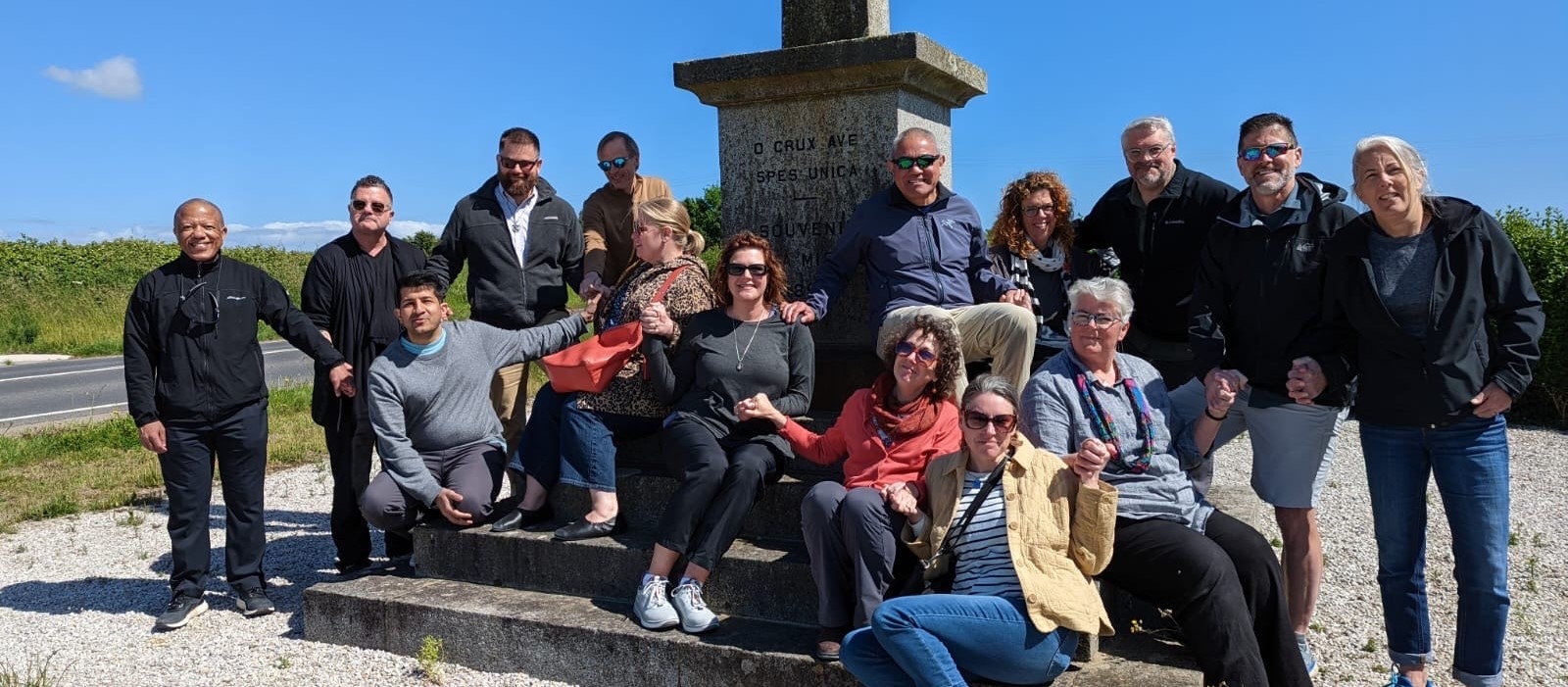
UP faculty members gathered at Mont Saint Michel
THIS SUMMER, FIFTEEN University of Portland faculty members embarked on a pilgrimage to the Basse-Normandie region of France. Their goal? A deeper connection to the school’s Holy Cross roots, including the order’s abiding commitment to community.
Their experience was animated by the question: How does an “I” become a “We”? Portland magazine asked the pilgrims to share their memories and impressions. From short, inspiring lectures delivered on their tour bus to private reflections and prayers, what came in was a rich tapestry of moments—humble, challenging, holy—that serve as a testament to the staying power of Blessed Basil Moreau’s vision of co-discipleship.
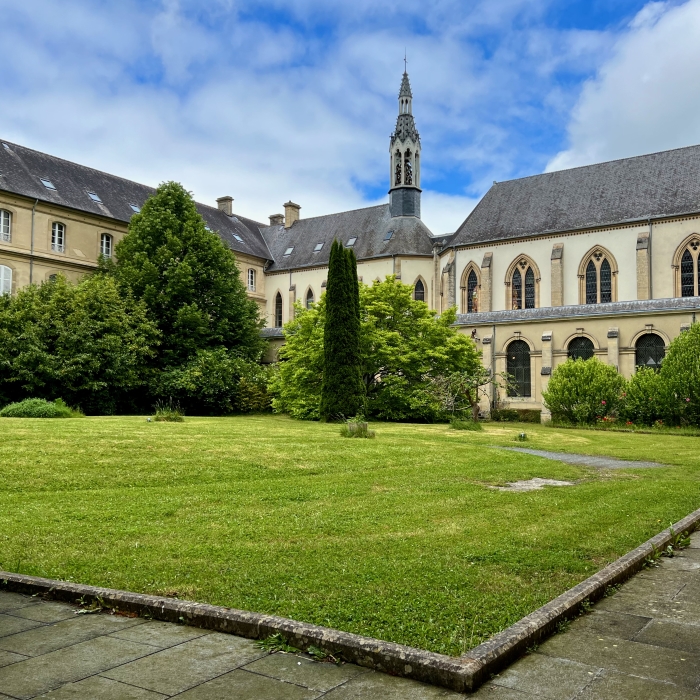
St. Benôit Monastery (Photo by Eric Anctil)
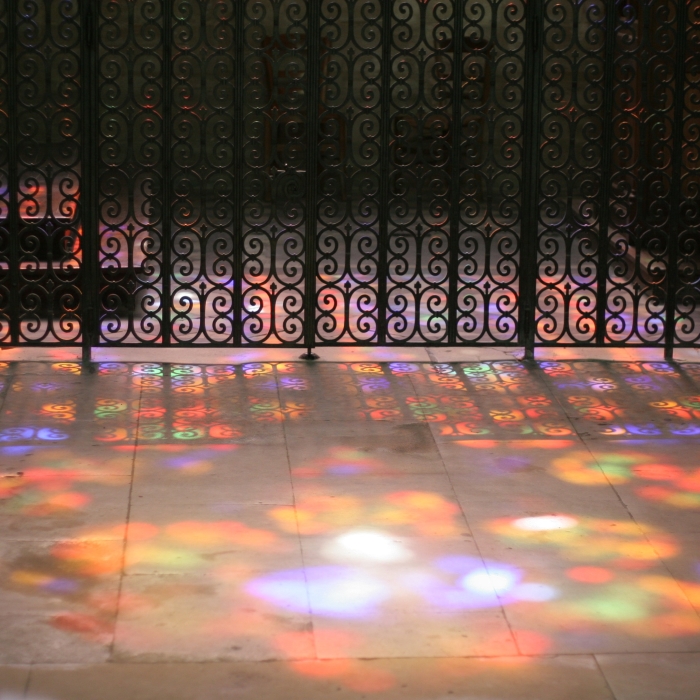
Evening light filters through stained glass creating beautiful colors on the monastery floor. (Photo by Piblet)
1. ST. BENÔIT BENEDICTINE MONASTERY, BAYEUX
This cloistered Benedictine community of women is a vivid example of the “source material” that Moreau drew upon in laying out the original Constitutions. The Congregation of Holy Cross draws from the local culture, so there is a Benedictine strain, notably a balance of apostolic work with prayer. The visit was also a beautiful way to explore and experience the eclectic spiritualities that comprise Catholicism.
On the first day there, Sr. Cecile, OSB, gave us a tour of the monastery and said that we are all called to be saints. This was a challenge for me. I don’t know many people who aspire to sainthood. I think of someone like Mother Theresa, people who led their lives beyond themselves for no personal gain. It seems almost impossible to achieve. Later that evening, I brought my questions to Fr. Jim Gallagher, CSC, and he encouraged me to think about sainthood in a different way. He spoke about his grandmother, who he thinks is a saint. She isn’t famous, but to him, sainthood is answering the call to live a good life. I feel a lot more hopeful about the idea, as if it could be a challenge and an aspiration.
Brian Fabien, Dean of the Shiley School of Engineering
Although raised Catholic, I had never attended Complines or any type of daily prayer. Each night at St. Benôit we were invited to join the sisters as they used their collective voices to thank God for the day, asking for God’s grace and love in holding them through the night, whatever that night should bring. Each evening increased my peace in the certainty of those voices lifting up the same words of gratitude and acceptance. I grew to appreciate the calming effect of this meditative evening ritual that tethered my wandering mind to the moment. Sr. Cecile shared with us that, after many years at the monastery, she began to see God’s presence in the shifting light of the chapel. I sought that light and noticed the different ways it filtered through the stained glass at 7:10-ish each evening. But I also saw the light in this collective of women; in their intentional choice to pray, live, and work together; in their melody; in the way they tended to animals and humans alike; in their deep compassion and their expression of their spirituality through ritual; in their care and devotion to one another. The light streamed in, but it also seemed to be refracted outward, this collaboration of women altering its path, giving it shape and structure.
Christi Hancock, Professor of history
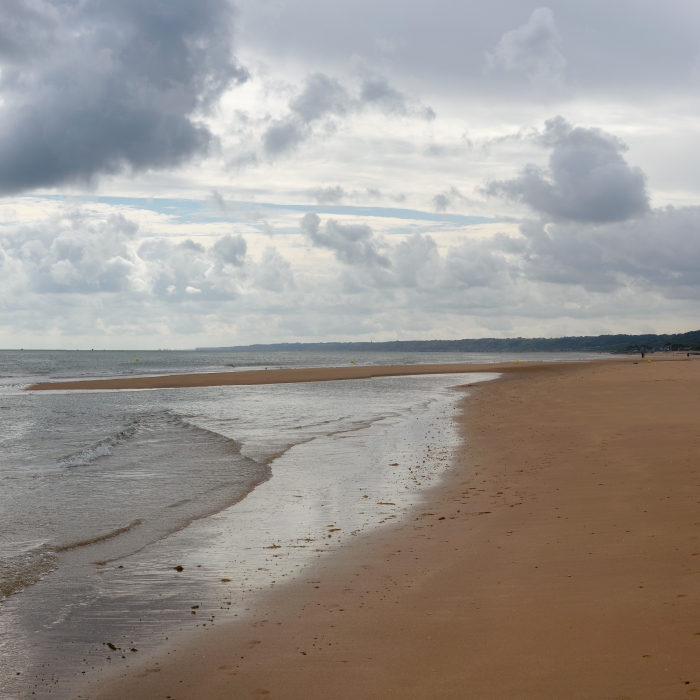
Omaha Beach, Normandy (Photo by Joe DeSousa)
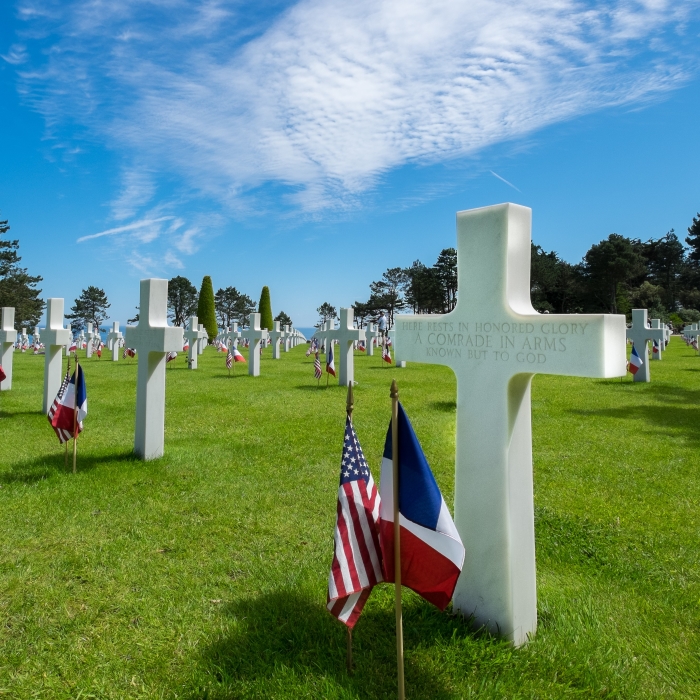
Normandy American Cemetery (Photo by Larry Uren)
2. OMAHA AND GOLD BEACHES
The Holy Cross charism of interdependence teaches us that we are all connected and beloved in the sight of God, that we are never to consider brothers and sisters as “other” or lesser. The tremendous and tragic loss of life represented by these spots is a visceral example of what happens when we lose sight of that lesson.
My late father enlisted in the army and started boot camp after his high school graduation. He was in training when D-Day took place. He never saw combat and felt like he missed out on defending his country like the other brave soldiers. Some were his friends who never returned. His army job was to process the honorable discharges once the war was over. He was obsessed with Omaha Beach and D-Day movies. He always wanted to visit. The day I stood on that beach and heard stories about the bravery, fear, bloodshed, and determination so many years ago, I was overcome with sadness and joy. He was always brave to me.
Gregory Pulver, Associate professor of drama
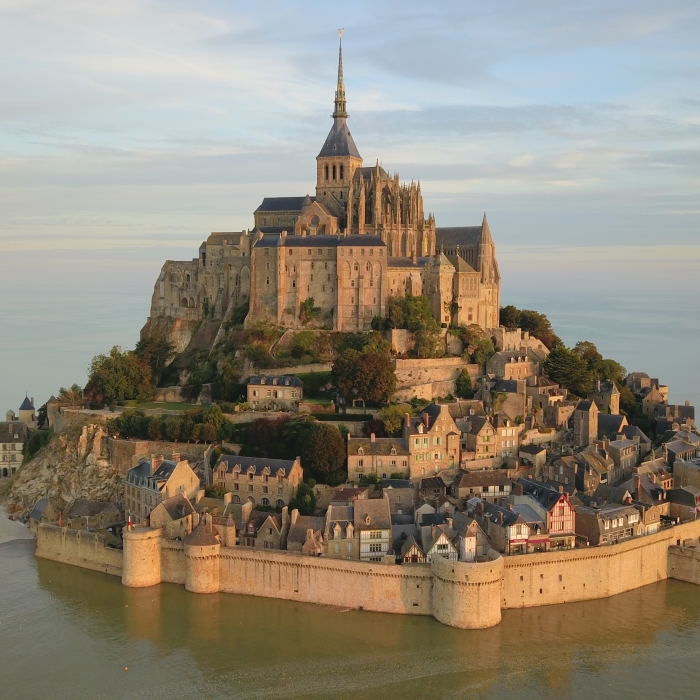
Mont Saint Michel (Photo by Amaustan)
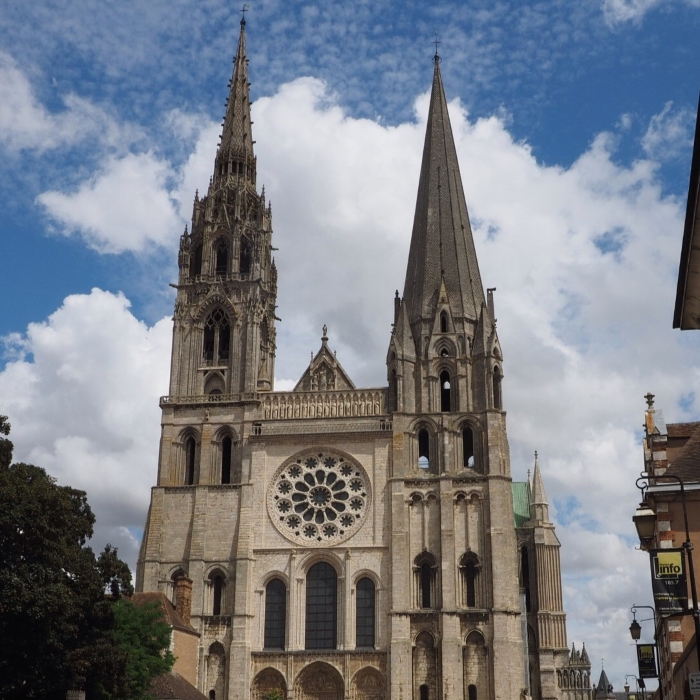
Chartres Cathedral (Photo by Clay Gilliand)
3. MONT SAINT-MICHEL
A pilgrimage destination for 1500 years, this visit allowed the group to connect to the venerable traditions of Christian pilgrimage, an entirely different expression of prayer.
I suspect that there are places on this planet where the veil between human-space and God-space is so thin that you almost exist in both realms at once; Mont Saint-Michel is such a place.
Steve Mayer, Professor and chair of chemistry and biochemistry
4. CRYPT CHAPEL IN CHARTRES CATHEDRAL
Mother Mary of the Seven Dolors came here to pray when Pope Gregory XVI was considering approving her new community of Marianite Sisters of Holy Cross. These Marianites are one of three orders of women associated with the Congregation of Holy Cross.
Nicole Hanig, associate professor, director of vocal studies, performed Poulenc’s “Priez pour paix” in this chapel. Below is a translation of the closing lines:
"Pray untiringly, we beg of you: Pray for peace, the true treasure of joy!"
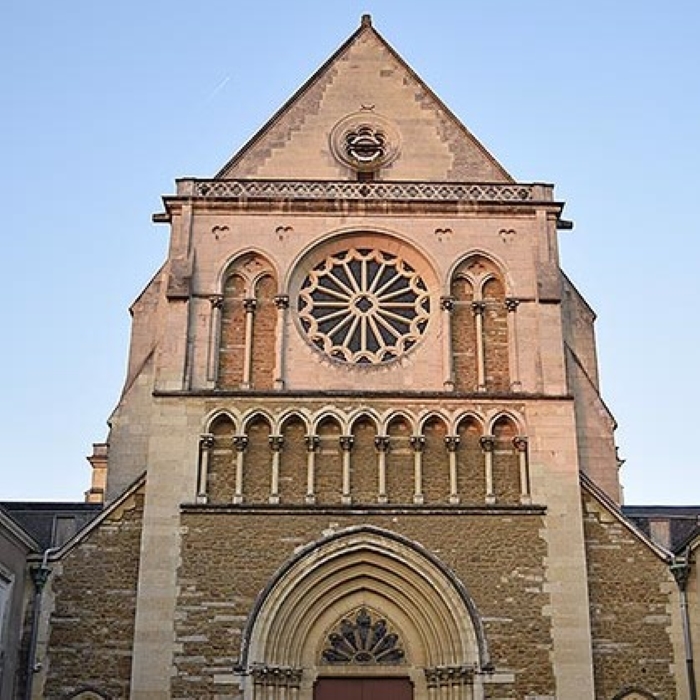
Notre-Dame de Sainte-Croix (Photo by Santctuaire Basile Moreau)
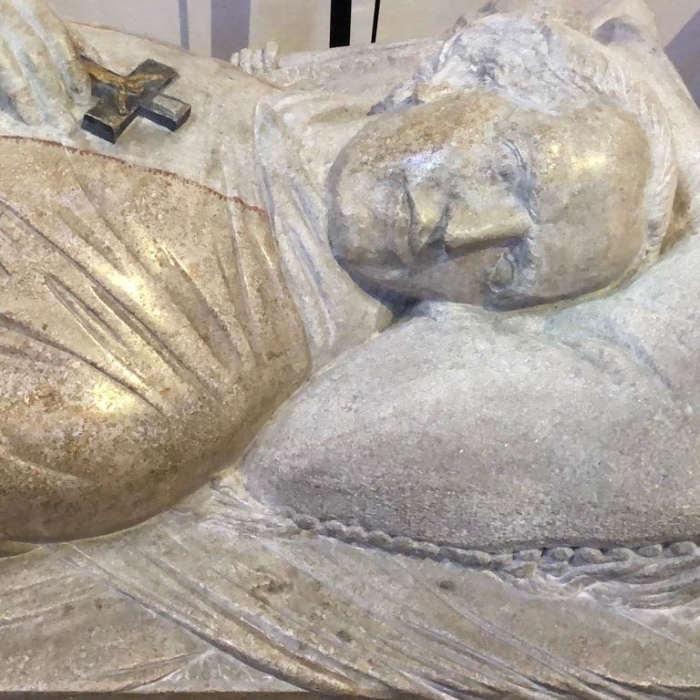
The tomb of Basil Moreau (Photo by Stephanie Salomone)
5. CHURCH OF NOTRE-DAME DE SAINTE-CROIX, LE MANS
Fr. Basil Moreau founded this parish church in 1857, twenty years after his fledgling community was up and running. Moreau is interred in the crypt there.
In the likeness that’s carved into his crypt’s stone top, Moreau faces left, he faces us, because he’s asking us,
“What will you do, then, to bring light and hope outside these walls? How will you serve? What actions will you take towards healing?”
And to me, “How will you teach and how will you lead so that others will know the joy of teaching, learning, wondering, leading, serving?”
These are action verbs, and these become action items on our to-do lists, but they are not things we check off because they are done. We are called to the promise of this work because it creates change for eternity, not just for today. We are called, maybe instructed, to look around and find out who needs us most, and to go to them. Our work is not done, and I finally understand, years later, something Fr. Bill Beauchamp once said: “When you pray, move your feet.” Our work here is a prayer, and Moreau asks us, with a glance over his left shoulder, to keep walking.
Stephanie Salomone, Associate dean for faculty, Shiley School of Engineering
6. THE TOUR BUS
What can you learn in 10 minutes?
You can learn that half of infinity is still infinite. That your body can trick its own pain receptors. That colors exude energy. That addiction to devices demonstrably diminishes our humanity. That just two kinds of gears make everything on any vehicle possible. That great singers are physics experts. That a tiny piece of plastic illuminates all the light we cannot see. That the original Rosie the Riveter was a composite of a woman’s face on a man’s body. And perhaps the biggest “aha” of all: that every single one of these facts is inextricably linked to the others.
Karen Eifler, Director of the Garaventa Center and professor of education
Portland magazine would like to thank the pilgrims: Eric Anctil, Karen Eifler, Brian Fabien, Fr. Jim Gallagher, CSC, Christin Hancock, Nicole Hanig, Andrew Guest, Herbert Medina, Gregory Pulver, Shaz Vijlee, Shannon Mayer, Steve Mayer, Stephanie Salomone, Heidi Senior, Casey Shillam.
More Stories
The Making of a President
Robert D. Kelly, UP’s 21st president, comes to the role with faith, experience, and hope for transformation.
- Story by Jessica Murphy Moo